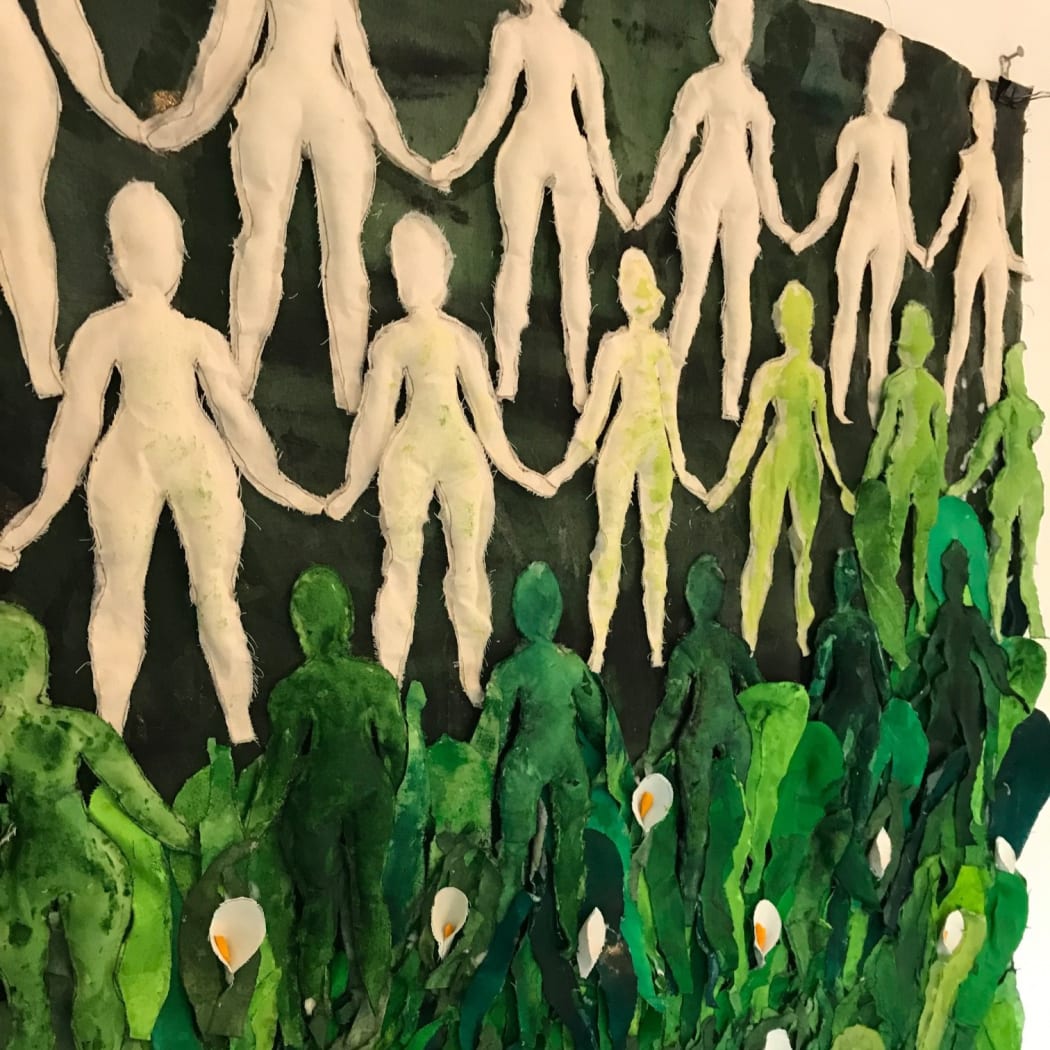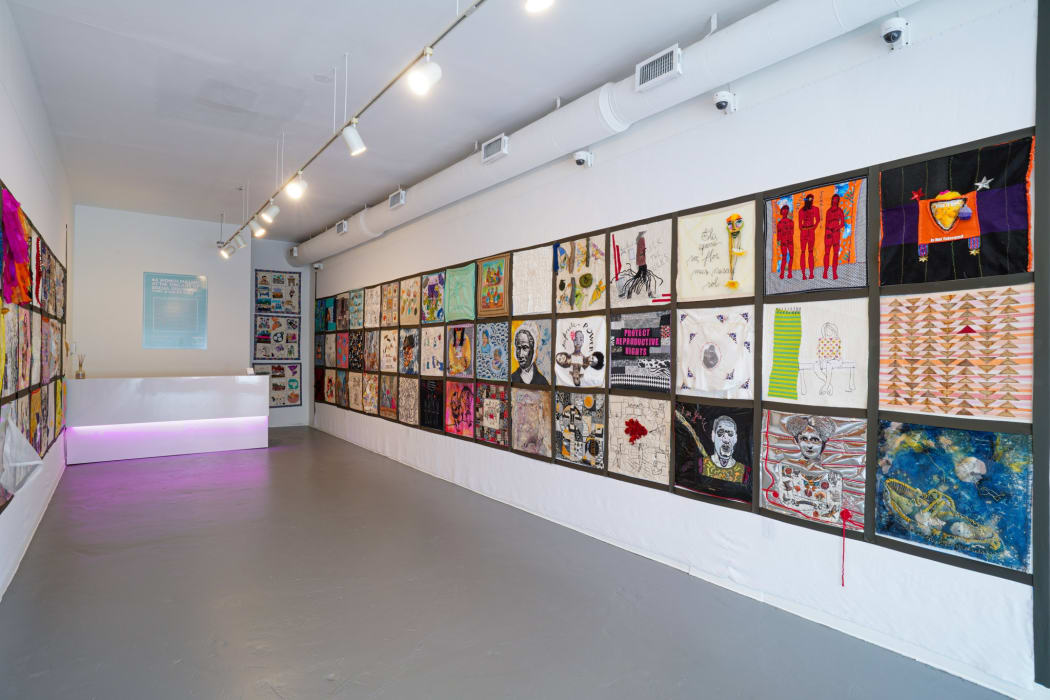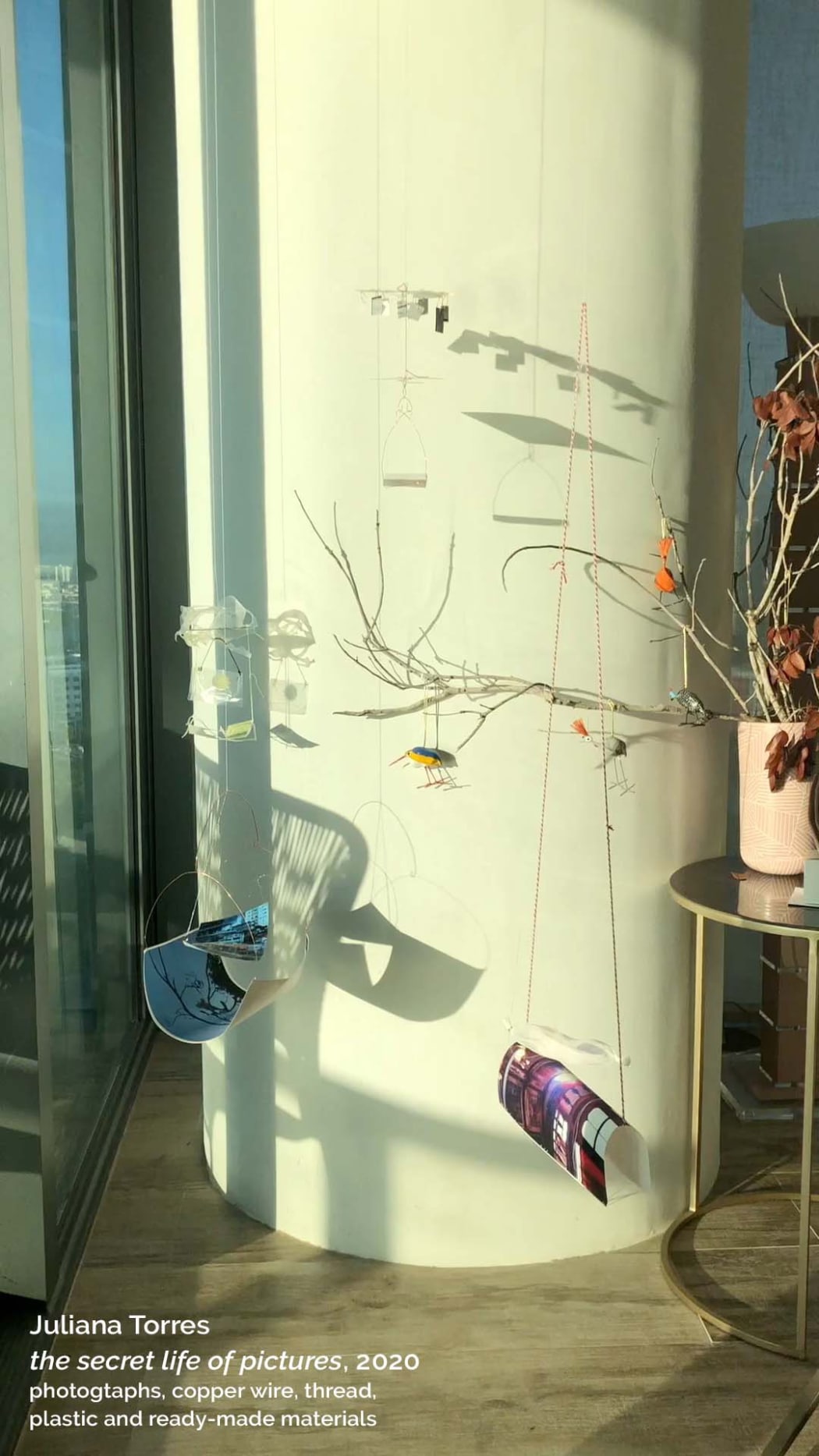-

We Got The Power Q&A XVI
“Each stitch becomes a thread that connects me to those who came before me, and through it, I’m honoring an art form that has historically been undervalued.” — Lauren JanuhowskiOur sixteenth Q&A roundup features Camp artists Hou Guan Ting and Eden Quispe, alongside artists Nicole Durham and Lauren Januhowski. -

We Got The Power Q&A XV
" While my mother’s ideas were valued, taking much time away from keeping a home and a family would not have been very strongly supported." — Nanilee RobargeOur Fifteenth Q&A roundup features CAMP artist Molly Gambardella, alongside artists Elaine Luther, Autumn Kioti Horne, and Nanilee Robarge.
-

We Got The Power Q&A XIV
“The beautiful thing about fiber art is so many of us learn through community–a close friend, a parent, a relative, or a local class. Craft is a unifier, and it is a practice that is now core to what I do.“— Kristina ReinisOur Fourteenth Q&A roundup features CAMP artists Amy Putman and Joan Wheeler , alongside artists Kristina Reinis and Ainaz Alipour. -

We Got The Power Q&A XIII
“Fiber's flexibility, texture, and historical depth make it an exciting, boundary-pushing medium for art." — Aida TejadaOur Thirteenth Q&A roundup features Camp artists Nancy Tobin , Sooo-z Mastropietro and Barbara Ringer along with artists Kim Moore, and Aida Tejada. -

We Got The Power Q&A XII
"I am finding new ways to explore the feminine universe in fabrics and embroidery." — Silvana SorianoOur Twelfth Q&A roundup features CAMP artists Silvana Soriano and Julie Peppito, along with artists Rosa Herniquez, and Toni Thomas .
-

We Got The Power Q&A IX
"There’s been so much social conditioning as to what role women must play in society. Learning to identify and confront this damaging and limiting way of thinking is a good place to start." — Yanira LopezOur ninth Q&A roundup features artists Valeria Montag, Fernanda Froes, Debora Rosental, and Yanira Lopez. -

We Got The Power Q&A VIII
“ In this piece and my work in general, I’m offering a point of view where the aim is to return the gaze that has so often been male – with one displaying women’s solidarity, power, and focus on change for a better world “ — Fruma Markowitz.Our eighth Q&A roundup features CAMP artist Margaret Roleke who is joined by artists Delaney Conner, Isabel Infante, and Fruma Markowitz.
-

We Got The Power Q&A VI
" So many women are conditioned to NOT speak up. It's important that we use our power to help the world, not just ourselves " - Kathy NidaOur sixth Q&A roundup features CAMP artist Manju Shandler who is joined by artists Marcia Manconi, Alieh Rezaei and Alexis Oliva. -

We Got The Power Q&A IV
"...art unites worlds, art is the maximum expression of the human being, the most sublime..." - Brenda KuongOur fourth Q&A roundup features artists Atelierlustig, Brenda Kuong, Carlos Bautista Biernnay and Nancy Ofori. -

We Got The Power Q&A V
" As long as there is an outlet for women's voices to be heard, women must speak " - Marcia ManconiOur fith Q&A roundup features CAMP artist Camille Eskell who is joined by artists Marcia Manconi, Alieh Rezaei and Alexis Oliva.
-

We Got The Power Q&A III
“Both in the ancient play and in today's context, women continue to fight for their rights, underscoring the timelessness and resilience of our struggle.” - Eileen HoffmanOur third Q&A roundup features CAMP artists Karola Pezarro and Alina Rodriguez Rojo, joined by artists Rima Day and Eileen Hoffman.
-

We Got the Power Q&A II
"I've always believed that the world would be a better place if ruled by women because women who have children understand the value of life." — Mary Tooley ParkerOur second Q&A roundup features CAMP artist Heidi Hankaniemi, joined by artists Melanie Brewster, Catherine Olivier, Mary Tooley Parker and Sarah Laing. -

We Got the Power Q&A I
"Greek political comedies are not my usual source of inspiration. Also, two months is a ridiculously short amount of time for me to make anything." — Deborah SimonOur first Q&A features CAMP artists Deborah Simon and Leslie Sheryll, joined by Lauren Reilly and Ola Rondiak. -
 As the exhibition This is Not a Doll's House continues in our North Miami space, we wanted to give the oppurtunity to shed some light on the finer details you might have missed out on with each artists work. Their inspirations, the analysis of the original Ibsen play, and their reactions to an ever-changing modern society norm all have major influences on their art, and that gives us great reasoning to prod their minds for the real reasons behind the Doll's House.This is part three of our interview series, if you'd like to go back to read the answers some of the artists gave in part one, CLICK HERE.
As the exhibition This is Not a Doll's House continues in our North Miami space, we wanted to give the oppurtunity to shed some light on the finer details you might have missed out on with each artists work. Their inspirations, the analysis of the original Ibsen play, and their reactions to an ever-changing modern society norm all have major influences on their art, and that gives us great reasoning to prod their minds for the real reasons behind the Doll's House.This is part three of our interview series, if you'd like to go back to read the answers some of the artists gave in part one, CLICK HERE. -

Inside a Doll's House - Act 1
The first part in a series of interview questions with the artists of This is Not a Doll's HouseAs the exhibition This is Not a Doll's House continues in our North Miami space, we wanted to give the oppurtunity to shed some light on the finer details you might have missed out on with each artists work. Their inspirations, the analysis of the original Ibsen play, and their reactions to an ever-changing modern society norm all have major influences on their art, and that gives us great reasoning to prod their minds for the real reasons behind the Doll's House.This is the first part of many as we give questions to each of the artists participating in the show, and each week we'll have another set of artists to see their responses to what our interviewer asked them. -

Tea Time with Melanie
Melanie finally writes in after a busy first quarter.It's been a while since we heard from the elusive Melanie Prapopoulos. The artist, gallery director, and den mother to a crew exclusively made up of creative twenty-somethings, has led CAMP into 2022 without stopping for a breath.
-

In Conversation with the Women Pulling at the Threads of Social Discourse
Laetitia Adam-Rabel, Viviana Romero, Sandra Onetti, Maria Lino, Leslie McKinley, Laura Marsh, and Nancy Billings reflect on fiber artistry and their purpose as creatives.As we continue our third-annual collaboration with Fiber Artists Miami Association, the exhibition, Women Pulling at the Threads of Social Discourse, continues to reveal just how layered the original premise is at its core. If there's anything we've learned over the years, it's that fiber's adaptable quality extends beyond its material capabilites. The idea that textile art holds a dual nature in its capacity to be equally tender and jarring brings about necessary, albeit poignant, questions of its role within the context of "fine" art, as well as just how much validity our societies are willing to afford to the feminine experience.
This year's edition, which features 100 pieces displayed as massive quilt, can be explored from perspectives totaling to the same, whether they're present subconsciously or explicitly. What is certain and unquestionable is that the democratization of the fine art industry allows us, the audience, to interrogate ourselves better, and more deeply, than a run-of-the mill homogeneity allows. Whether one feels uncomfortable, affrimed, or like they've learned something they weren't expecting to, what unites both the artists and the audience is the idea that self-expression isn't something personal, and instead something that is more often than not done in the same of unity.
In typical CAMP fashion, we're interested in what the artists have to say—about their relationship with textiles, whether fiber art and fine art are as mutually exclusive as we've been lead to believe, and about their nature as artists. Read on to get to know Laetitia Adam-Rabel, Natalia Schonowski, Viviana Romero, Sandra Onetti, Maria Lino, Leslie McKinley, Laura Marsh, and Nancy Billings.
-
 Juliana Torres. the secret life of pictures, 2020.
Juliana Torres. the secret life of pictures, 2020.Juliana Torres: When Art Embraces Real Life
The Role of Non-Artistic, Ordinary Materials in Art DemocratizationThe Contemporary Art Modern Project is also known as The CAMP Gallery—but we've grown to become a platform for artists and artistic endeavors across the board.
As such, we're honored to feature Juliana Torres' final thesis When Art Embraces Real Life: The Role of Non-Artistic, Ordinary Materials in Art Democratization. You can view Torres' contribution to our upcoming exhibition, the third-annual installment of Women Pulling at the Threads of Social Discourse, opening October 1, 2021.